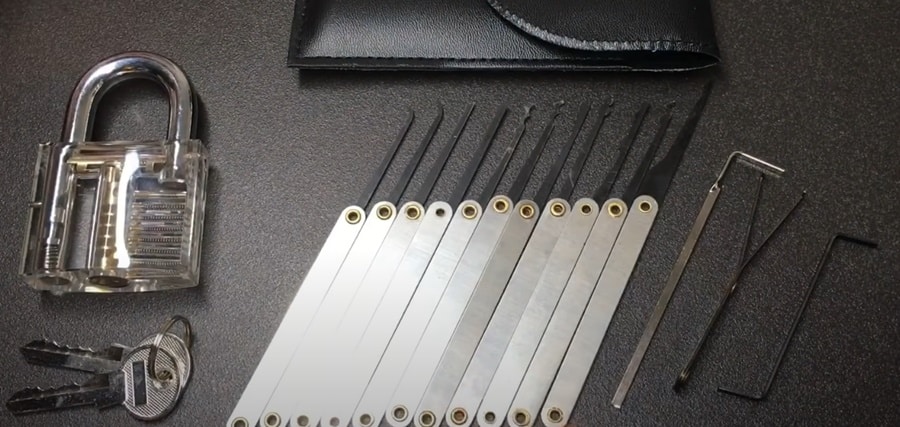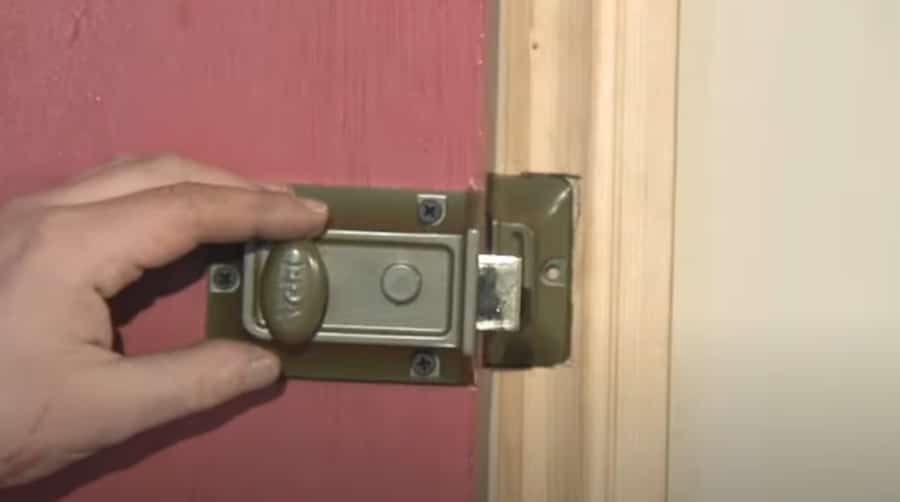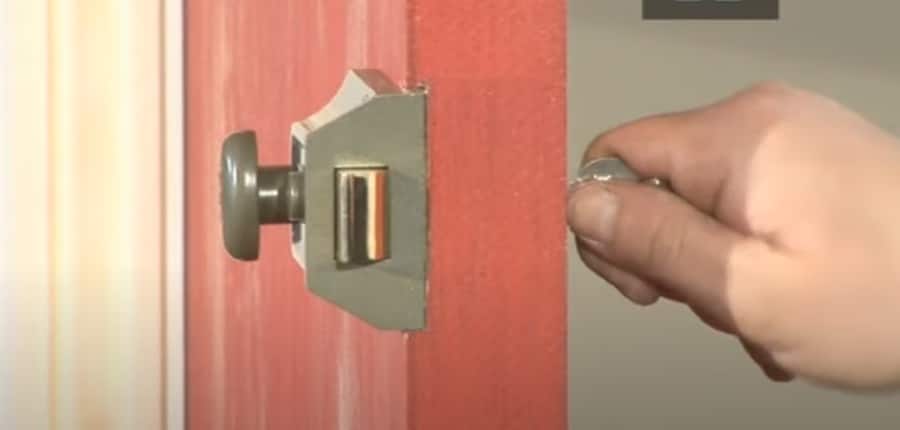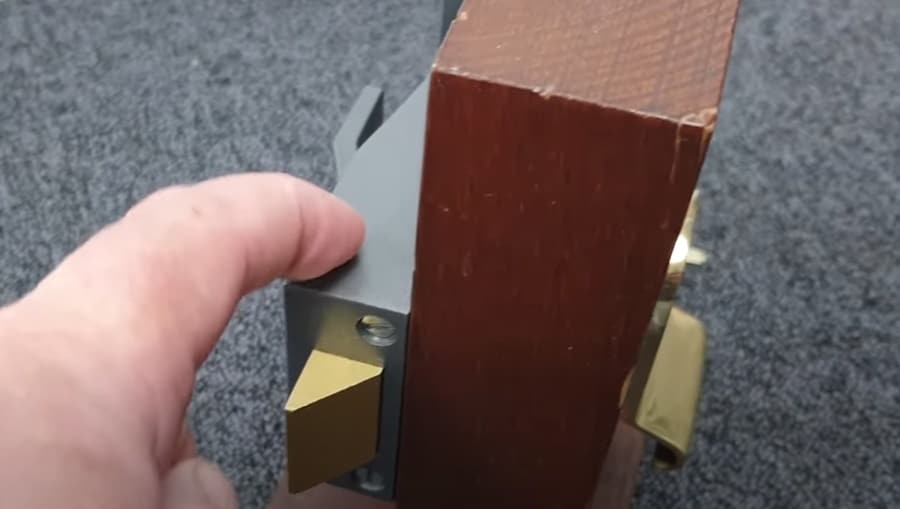This article explores both aspects: the methods to open a night latch from the outside in emergencies and the strategies to reinforce them to prevent unwanted entry.
Introduction
Night latch locks are familiar on many residential doors, offering convenience and security. These locks, often called ‘night latches,’ are known for their ease of use and the peace of mind they provide homeowners.
However, there may be instances, such as during lockouts, when understanding how to open these locks from the outside becomes essential. Conversely, knowing how to secure these locks against unauthorized access is equally important.
This article explores both aspects: the methods to open a night latch from the outside in emergencies and the strategies to reinforce them to prevent unwanted entry.
Prepare Tools to Open A Night Latch Lock From the Outside

Opening a night latch lock, especially from the outside, requires specific tools and expertise. Whether you’re a professional locksmith, a homeowner looking to enhance your skills or someone who’s locked out, it’s essential to be familiar with the tools of the trade.
Here’s a list of common tools used for opening night latch locks:
- Lock Picks: Lock picking is an art, and with the right set of picks, one can open various locks. Different types of picks, such as hook, ball, and diamond, are designed for specific lock mechanisms.
- Tension Wrench: A tension wrench is inserted into the bottom of the keyhole to apply pressure on the lock’s pins, making it easier to manipulate them with the pick. It is used in conjunction with lock picks.
- Bump Key: A bump key is a specially crafted key that, when inserted into the lock and struck with a mallet or hammer, can force the pins inside the lock to jump, potentially unlocking it.
- Door Shim: A thin piece of plastic or metal, a door shim, can be slid between the door and the frame to manipulate the latch, especially in traditional night latches.
- Air Wedge: Used primarily for car doors but sometimes applicable to certain door types, an air wedge is inserted into the door gap and inflated, creating space to insert other tools.
- Decoder Tool: Specifically designed for certain types of locks, a decoder tool can determine the lock’s pin configuration, allowing for the creation of a working key.
- Lubricant: Sometimes, locks can become jammed due to rust or debris. A lubricant can help smoothen the lock mechanism, making it easier to open.
Safety Precautions When Using These Tools
- Always Seek Permission: Never open a lock without the owner’s permission. Unauthorized lock picking is illegal and unethical.
- Wear Protective Gloves: Some tools can be sharp, and there’s always a risk of pinching or cutting your fingers. Wearing gloves can provide an added layer of protection.
- Use Tools Appropriately: Always use tools for their intended purpose. Forcing a tool can damage the lock or the tool itself.
- Stay Calm: It’s essential to remain calm and patient, especially in latch-lock lockout situations. Rushing can lead to mistakes or damage.
- Be Aware of Surroundings: Ensure you’re working in a well-lit area and be mindful of others around you, especially if using tools that could harm someone if mishandled.
- Store Tools Safely: When not in use, store your tools securely away from children and others who might misuse them.
Remember, while these tools can be beneficial in lockout situations, they should be used responsibly and ethically. If unsure, always seek the assistance of a professional locksmith.
Step 1: Preparing the Door and Surroundings:
- Assess the Situation: Before opening the lock, determine the type of night latch you’re dealing with. This will help you choose the right technique and tools.
- Clear the Area: Ensure enough space around the door for you to work comfortably. Remove any obstructions or items that might be in the way.
- Gather Necessary Tools: Based on the type of lock, gather the tools you’ll need. This might include lock picks, tension wrenches, bump keys, etc.
- Ensure Proper Lighting: If working in a dimly lit area, use a flashlight or headlamp to illuminate the lock and surrounding area.
Step 2: Open a Traditional Night Latch from outside:
- Use a Door Shim: Slide a door shim between the door and the frame, targeting the latch. Push and wiggle the shim until the latch retracts, allowing the door to open.
- Lock Picking: Insert a tension wrench into the bottom of the keyhole and apply slight pressure. Use a lock pick to manipulate the pins inside until it unlocks.
Step 3: Open a Deadlocking Night Latch:
- Bump Key Method: Insert the bump key into the lock and give it a sharp tap with a mallet or hammer. This might cause the pins to jump, unlocking the door.
- Lock Picking: As with the traditional night latch, use a tension wrench and lock pick to manipulate the pins and unlock the door.
Step 4: Open an Auto Deadlocking Night Latch:
- Decoder Tool: Use a decoder tool to determine the lock’s pin configuration. Once you have this information, you can create a working key or use it to pick the lock more effectively.
- Lock Picking: This method might be more challenging for auto-deadlocking night latches, but with patience and skill, it can be effective.
Step 5: Open a Double Locking Night Latch:
- Two-Step Picking: Since there are two locking mechanisms, you might need to pick the lock twice – once for the latch and once for the deadlock.
- Bump Key: A bump key can be effective, but you might need to bump the lock multiple times to disengage both locking mechanisms.
Remember, while these techniques can be helpful, always ensure you have the right to access the locked area. Unauthorized entry is illegal and unethical.
Alternative Methods of Opening Night Latch Locks

Non-Destructive Methods:
- Credit Card Technique: This classic method involves sliding a credit card or a similar thin, flexible piece of plastic between the door and the frame, targeting the latch.
- Step 1: Select an Appropriate Tool: A rigid yet flexible plastic card, like a credit card or a plastic loyalty card, often works best. Avoid using important cards like your actual credit card to prevent damage.
- Step 2: Insert the Card: Slide the card between the door and the frame, aligning it with the latch of the night latch lock.
- Step 3: Manipulate the Latch: Gently wiggle and push the card downwards while applying pressure towards the door. The goal is to push the latch back into the lock mechanism, allowing the door to open.
- Step 4: Open the Door: Once the latch is pushed back, turn the handle and open the door. Be gentle to avoid damaging the door or lock.
- Using a Plastic Bottle:
- Step 1: Prepare a Plastic Strip: Cut a long, flexible strip from a plastic bottle.
- Step 2: Insert the Strip: Slide the strip between the door and the frame above the latch.
- Step 3: Flick the Latch: Push the strip down and then flick it upwards, aiming to catch the latch and push it back into the door.
- Step 4: Open the Door: Gently open the door once the latch is disengaged.
- Electric Pick Guns: These devices work by rapidly striking the pins inside the lock, simulating the effect of a bump key but with more consistency. They can be effective on various night latch types but require some skill.
Last-Resort Techniques:
- Drilling: This method involves drilling a hole through the lock to destroy the internal mechanism, allowing the door to be opened. While effective, it renders the lock unusable and requires a replacement.
- Breaking the Door or Window: In extreme emergencies, especially when time is of the essence, breaking a nearby window or even the door itself might be considered. This destructive method should only be used when all other options have been exhausted and immediate entry is crucial.
- Bolt Cutters: If the door has a chain or secondary locking mechanism, bolt cutters can be used to cut through these barriers. This method destroys the secondary lock but might leave the primary night latch intact.
- Prying or Forcing the Door: The door can be pried open using tools like crowbars or even brute force. This method can damage the door, frame, and lock.
In conclusion, while alternative entry methods can be effective, they should be cautiously approached. Non-destructive methods are preferable as they preserve the integrity of the lock and door. However, in emergencies, last-resort techniques might be necessary.
Common Mistakes to Avoid

Attempting to open a night latch lock, especially without proper knowledge or tools, can lead to several mistakes. These errors can damage the lock, the door, or even personal injury. Here’s a list of common mistakes and how to prevent them:
- Applying Excessive Force: Many believe applying more force, whether using a bump key or a lock pick, will expedite the unlocking process. This can lead to broken tools, damaged locks, or even a broken key stuck inside the lock. Always start with gentle pressure and increase it gradually.
- Using Improper Tools: Using makeshift tools or tools not designed for the specific lock type can damage the lock mechanism or the door frame. Always use tools specifically designed for lock picking or unlocking. If you don’t have the right tool, it’s better to wait or seek professional help.
- Overlooking the Lock Type: Not all night latch locks are the same. Using a technique suitable for a traditional night latch on a double-locking night latch can be ineffective and potentially damaging. Before attempting any unlocking method, assess the lock type and adjust your approach accordingly.
- Ignoring Safety Precautions: Not taking safety precautions can lead to personal injuries, especially when using tools or applying force. Wear protective gloves, work in a well-lit area, and ensure stable footing. Keep your face away from the lock when using bumping methods to avoid sudden impacts.
- Not Seeking Professional Help When Needed: Trying to unlock a challenging lock without success can lead to frustration and potential damage. If you’ve tried multiple methods without success, it’s wise to call a professional locksmith. They have the expertise and tools to handle complex situations.
- Neglecting to Lubricate a Jammed Lock: Forcing a key or tool into a jammed or rusty lock can cause the lock to break or the tool to get stuck. If a lock seems jammed, apply a lubricant to smoothen the mechanism before attempting to unlock it.
- Not Checking the Door’s Condition: Older doors or those with visible damage can be more susceptible to damage during the unlocking process. Assess the door’s condition before applying any force or techniques. If the door seems weak or damaged, proceed with caution.
In conclusion, while unlocking a night latch lock might seem straightforward, it’s essential to approach the task with knowledge, patience, and the right tools. Avoiding common mistakes can save you time, money, and potential headaches.

While the provided content primarily focuses on how to open a night latch lock from the outside, I can infer and suggest avoiding the unauthorized opening of a lock based on the information given.
- Upgrade Your Lock: Modern versions of night latch locks, such as the Yale night latch, offer double locking features — locking from both the inside and the outside. This added layer of security makes it more challenging for unauthorized individuals to gain access.
- Use the Snib Feature: The defining feature of a night latch lock is the snib. When the snib of the night latch lock is raised, the night latch cannot be opened from either side. Ensure the snib is engaged when inside or leaving the house for extended periods.
- Install a Secondary Lock: Consider adding a secondary lock, such as a deadbolt or a chain lock, to your door. This provides an additional barrier against unauthorized entry.
- Regular Maintenance: Ensure that your night latch is in good working condition. A worn-out or malfunctioning lock can be easier to bypass.
- Avoid Displaying Valuables: If potential intruders see valuable items inside your home, they might be more motivated to try and gain entry. Keep valuables out of sight from windows and doors.
- Install Security Systems: Consider adding security cameras, alarms, or motion sensor lights around entry points. The presence of these systems can deter potential intruders.
- Educate Family Members: Ensure all family members know the importance of engaging the night latch and other security measures.
- Be Wary of Sharing Information: Avoid discussing your home’s security measures or routines publicly or online. The more information potential intruders have, the easier it might be for them to plan a break-in.
In conclusion, while night latch locks offer convenience and security, additional measures are essential to ensure they cannot be easily bypassed from the outside. Prioritizing safety and security will help protect your home and loved ones from potential threats.

